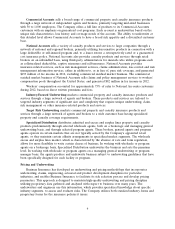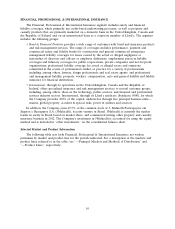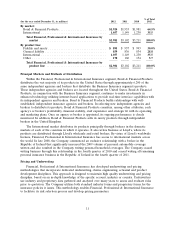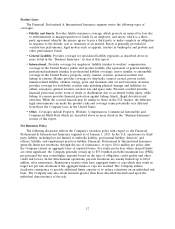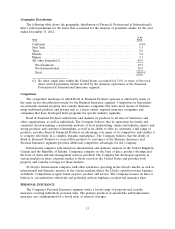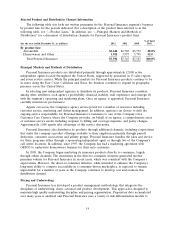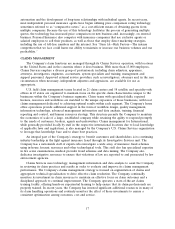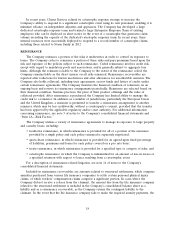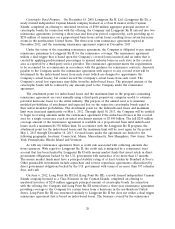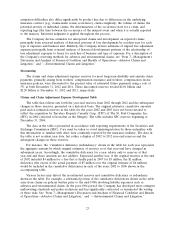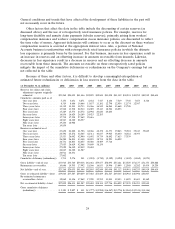Travelers 2012 Annual Report Download - page 27
Download and view the complete annual report
Please find page 27 of the 2012 Travelers annual report below. You can navigate through the pages in the report by either clicking on the pages listed below, or by using the keyword search tool below to find specific information within the annual report.facilitate its pricing segmentation. The Company’s product management area establishes underwriting
guidelines integrated with its filed pricing and rating plans, which enable Personal Insurance to
effectively execute its risk selection and pricing processes.
Pricing for personal automobile insurance is driven in large part by changes in the frequency of
claims and by inflation in the cost of automobile repairs, medical care and litigation of liability claims.
Pricing in the homeowners business is driven in large part by changes in the frequency of claims and by
inflation in the cost of building supplies, labor and household possessions. In addition to the normal
risks associated with any multiple peril coverage, the profitability and pricing of both homeowners and
automobile insurance are affected by the incidence of natural disasters, particularly those related to
weather and, for homeowners insurance, earthquakes. Insurers writing personal lines property and
casualty policies may be unable to increase prices until some time after the costs associated with
coverage have increased, primarily because of state insurance rate regulation. The pace at which an
insurer can change rates in response to increased costs depends, in part, on whether the applicable
state law requires prior approval of rate increases or notification to the regulator either before or after
a rate change is imposed. In states with prior approval laws, rates must be approved by the regulator
before being used by the insurer. In states having ‘‘file-and-use’’ laws, the insurer must file rate changes
with the regulator, but does not need to wait for approval before using the new rates. A ‘‘use-and-file’’
law requires an insurer to file rates within a period of time after the insurer begins using the new rate.
Approximately one-half of the states require prior approval of most rate changes. In addition, changes
to methods of marketing and underwriting in some jurisdictions are subject to state-imposed
restrictions, which can make it more difficult for an insurer to significantly manage catastrophe
exposures.
The Company’s ability or willingness to raise prices, modify underwriting terms or reduce exposure
to certain geographies may be limited due to considerations of public policy, the evolving political
environment, changes in the general economic climate and/or social responsibilities. The Company also
may choose to write business it might not otherwise write in some states for strategic purposes, such as
improving access to other commercial or personal underwriting opportunities. In choosing to write
business in some states, the Company also considers the costs and benefits of those states’ residual
markets and guaranty funds, as well as other property and casualty business the Company writes in
those states.
Personal Insurance utilizes technology intended to maximize independent agents’ ease of doing
business with the Company. Automated quote transactions can be submitted online by independent
agents either through Personal Insurance’s proprietary platform, their own agency management
platform or comparative raters (discussed in more detail in the ‘‘Competition’’ section that follows).
Nearly all new business policies can be issued online either by using the agents’ own platform or
Personal Insurance’s platform, both of which interface with Personal Insurance’s underwriting and
rating systems to monitor transactions for compliance with the company’s underwriting and pricing
programs. All online business is subject to consultative review by Personal Insurance’s in-house
underwriters. Audits of on-line business are conducted by an internal review team using systematic
sampling across all of the Company’s distribution channels.
Product Lines
The primary coverages in Personal Insurance are personal automobile and homeowners and other
insurance sold to individuals. Personal Insurance had approximately 7.3 million active policies
(e.g., policies-in-force) at December 31, 2012.
The Personal Insurance segment writes the following types of coverages:
•Personal Automobile provides coverage for liability to others for both bodily injury and property
damage, uninsured motorist protection, and for physical damage to an insured’s own vehicle
15



